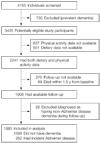Physical activity, diet, and risk of Alzheimer disease
- PMID: 19671904
- PMCID: PMC2765045
- DOI: 10.1001/jama.2009.1144
Physical activity, diet, and risk of Alzheimer disease
Abstract
Context: Both higher adherence to a Mediterranean-type diet and more physical activity have been independently associated with lower Alzheimer disease (AD) risk but their combined association has not been investigated.
Objective: To investigate the combined association of diet and physical activity with AD risk.
Design, setting, and patients: Prospective cohort study of 2 cohorts comprising 1880 community-dwelling elders without dementia living in New York, New York, with both diet and physical activity information available. Standardized neurological and neuropsychological measures were administered approximately every 1.5 years from 1992 through 2006. Adherence to a Mediterranean-type diet (scale of 0-9; trichotomized into low, middle, or high; and dichotomized into low or high) and physical activity (sum of weekly participation in various physical activities, weighted by the type of physical activity [light, moderate, vigorous]; trichotomized into no physical activity, some, or much; and dichotomized into low or high), separately and combined, were the main predictors in Cox models. Models were adjusted for cohort, age, sex, ethnicity, education, apolipoprotein E genotype, caloric intake, body mass index, smoking status, depression, leisure activities, a comorbidity index, and baseline Clinical Dementia Rating score.
Main outcome measure: Time to incident AD.
Results: A total of 282 incident AD cases occurred during a mean (SD) of 5.4 (3.3) years of follow-up. When considered simultaneously, both Mediterranean-type diet adherence (compared with low diet score, hazard ratio [HR] for middle diet score was 0.98 [95% confidence interval {CI}, 0.72-1.33]; the HR for high diet score was 0.60 [95% CI, 0.42-0.87]; P = .008 for trend) and physical activity (compared with no physical activity, the HR for some physical activity was 0.75 [95% CI, 0.54-1.04]; the HR for much physical activity was 0.67 [95% CI, 0.47-0.95]; P = .03 for trend) were associated with lower AD risk. Compared with individuals neither adhering to the diet nor participating in physical activity (low diet score and no physical activity; absolute AD risk of 19%), those both adhering to the diet and participating in physical activity (high diet score and high physical activity) had a lower risk of AD (absolute risk, 12%; HR, 0.65 [95% CI, 0.44-0.96]; P = .03 for trend).
Conclusion: In this study, both higher Mediterranean-type diet adherence and higher physical activity were independently associated with reduced risk for AD.
Figures



Comment in
-
Mediterranean diet and late-life cognitive impairment: a taste of benefit.JAMA. 2009 Aug 12;302(6):686-7. doi: 10.1001/jama.2009.1149. JAMA. 2009. PMID: 19671912 Free PMC article. No abstract available.
-
Diet, exercise habits, and risk of Alzheimer disease.JAMA. 2009 Dec 9;302(22):2431; author reply 2431-2. doi: 10.1001/jama.2009.1790. JAMA. 2009. PMID: 19996394 No abstract available.
References
-
- Hakim AA, Petrovitch H, Burchfiel CM, et al. Effects of walking on mortality among nonsmoking retired men. N Engl J Med. 1998;338(2):94–99. - PubMed
-
- Weuve J, Kang JH, Manson JE, et al. Physical activity, including walking, and cognitive function in older women. JAMA. 2004;292(12):1454–1461. - PubMed
-
- Larson EB, Wang L, Bowen JD, et al. Exercise is associated with reduced risk for incident dementia among persons 65 years of age and older. Ann Intern Med. 2006;144(2):73–81. - PubMed
-
- Podewils LJ, Guallar E, Kuller LH, et al. Physical activity, APOE genotype, and dementia risk. Am J Epidemiol. 2005;161(7):639–651. - PubMed
Publication types
MeSH terms
Substances
Grants and funding
LinkOut - more resources
Full Text Sources
Other Literature Sources
Medical

